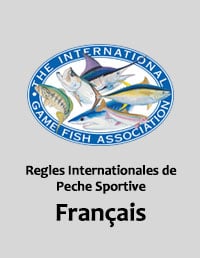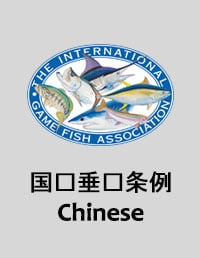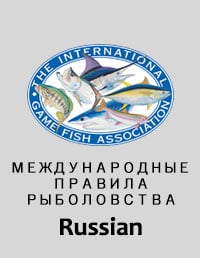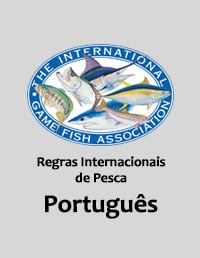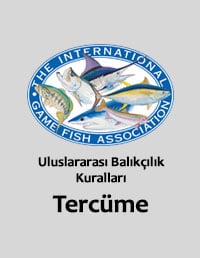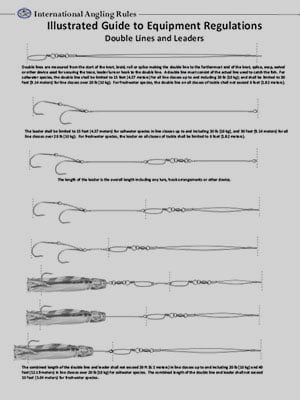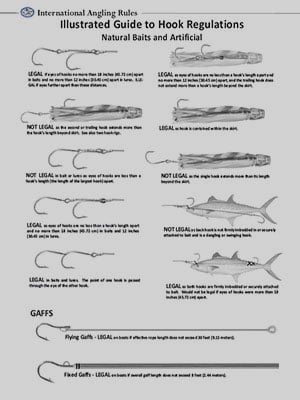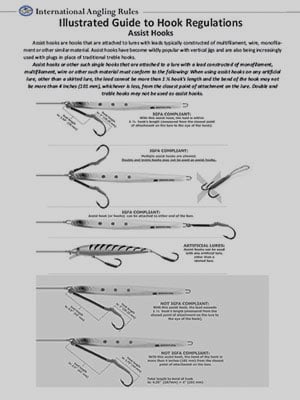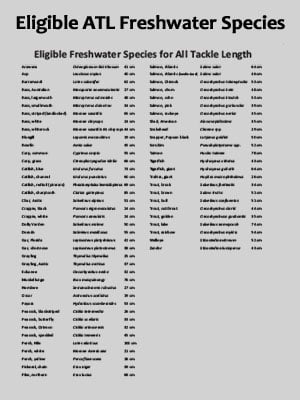IGFA International Angling Rules
The following angling rules have been formulated by the International Game Fish Association to promote ethical and sporting angling practices, to establish uniform regulations for the compilation of world game fish records, and to provide basic angling guidelines for use in fishing tournaments and any other group angling activities.
The word "angling" is defined as catching or attempting to catch fish with a rod, reel, line, and hook as outlined in the international angling rules. There are some aspects of angling that cannot be controlled through rule making, however. Angling regulations cannot insure an outstanding performance from each fish, and world records cannot indicate the amount of difficulty in catching the fish. Captures in which the fish has not fought or has not had a chance to fight do not reflect credit on the fisherman, and only the angler can properly evaluate the degree of achievement in establishing the record.
Only fish caught in accordance with IGFA international angling rules, and within the intent of these rules, will be considered for world records. Following are the rules for freshwater and saltwater fishing and a separate set of rules for All-Tackle Length and Flyfishing.
Rules for Fishing in Freshwater and Saltwater
(Also see Rules for All-Tackle Length and Rules for Flyfishing)
Equipment Regulations
A. Line and Backing
1. Monofilament, multifilament, and lead core multifilament lines may be used. For line classes, see World Record Requirements.
2. Wire lines are prohibited.
3. The use of backing is permissible.
4. The catch shall be classified under the breaking strength of the first 16.5 feet (5-meters) of line directly preceding the double line, leader, or hook. This section must be comprised of a single, homogenous piece of line and may not exceed 130-pound (60-kilogram) line class.
B. Double Line
The use of a double line is not required. If one is used, it must meet the following specifications:
1. A double line must consist of the actual line used to catch the fish.
2. Double lines are measured from the start of the knot, braid, roll or splice making the double to the farthermost end of the knot, splice, snap, swivel or other device used for securing the trace, leader, lure or hook to the double line.
Saltwater species: In all line classes up to and including 20 lb (10 kg), the double line shall be limited to 15 feet (4.57 meters). The combined length of the double line and leader shall not exceed 20 feet (6.1 meters).
The double line on all classes of tackle over 20 lb (10 kg) shall be limited to 30 feet (9.14 meters). The combined length of the double line and leader shall not exceed 40 feet (12.19 meters).
Freshwater species: The double line on all classes of tackle shall not exceed 6 feet (1.82 meters). The combined length of the double line and the leader shall not exceed 10 feet (3.04 meters).
C. Leader
The use of a leader is not required. If one is used, it must meet the following specifications:
The length of the leader is the overall length including any lure, hook arrangement or other device, and is measured to the bend of the last hook. The leader must be connected to the line with a snap, knot, splice, swivel or other device. Holding devices are prohibited. There are no regulations regarding the material or strength of the leader.
Saltwater species: In all line classes up to and including 20 lb (10 kg), the leader shall be limited to 15 feet (4.57 meters). The combined length of the double line and leader shall not exceed 20 feet (6.1 meters).
The leader on all classes of tackle over 20 lb (10 kg) shall be limited to 30 feet (9.14 meters). The combined length of the double line and leader shall be limited to 40 feet (12.19 meters).
Freshwater species: The leader on all classes of tackle shall be limited to 6 feet (1.82 meters). The combined length of the double line and leader shall not exceed 10 feet (3.04 meters).
D. Rod
1. Rods must comply with sporting ethics and customs. Considerable latitude is allowed in the choice of a rod, but rods giving the angler an unfair advantage will be disqualified. This rule is intended to eliminate the use of unconventional rods.
2. The rod tip must be a minimum of 40 inches (101.6 cm) in length. The rod butt cannot exceed 27 inches (68.58 cm) in length. These measurements must be made from a point directly beneath the center of the reel. A curved butt is measured in a straight line. When the rod butt is placed in a gimbal, the measurement from the center of the reel seat to the pivot point of the gimbal can be no more than 27 inches. (The above measurements do not apply to surfcasting rods.)
E. Reel
1. Reels must comply with sporting ethics and customs.
2. Power driven reels of any kind are prohibited. This includes motor, hydraulic, or electrically driven reels, and any device that gives the angler an unfair advantage.
3. Ratchet handle reels are prohibited.
4. Reels designed to be cranked with both hands at the same time are prohibited.
F. Hooks and Bait Fishing
1. For live or dead bait fishing no more than two single hooks may be used. Both must be firmly imbedded in or securely attached to the bait. The eyes of the hooks must be no less than a hook's length (the length of the largest hook used) apart and no more than 18 inches (45.72 cm) apart. The only exception is that the point of one hook may be passed through the eye of the other hook.
A hook may not precede bait, lure or bait/lure combo by more than one hook’s length.
2. The use of a dangling or swinging hook is prohibited. Double or treble hooks are prohibited.
3. A two hook rig for bottom fishing is acceptable if it consists of two single hooks on separate leaders or drops. Both hooks must be imbedded in the respective baits and separated sufficiently so that a fish caught on one hook cannot be foul hooked by the other.
4. A photograph or sketch of the hook arrangement must accompany all record applications made for fish caught on two-hook tackle.
G. Hooks and Lures
1. When using an artificial lure with a skirt or trailing material, no more than two single hooks may be attached to the line, leader, or trace. The hooks need not be attached separately. The eyes of the hooks must be no less than an overall hook's length (the overall length of the largest hook used) apart and no more than 12 inches (30.48 cm) apart. The only exception is that the point of one hook may be passed through the eye of the other hook. The trailing hook may not extend more than a hook's length beyond the skirt of the lure. A hook may not precede bait, lure or bait/lure combo by more than one hook’s length. A photograph or sketch showing the hook arrangement must accompany a record application.
2. Gang hooks are permitted when attached to plugs and other artificial lures that are specifically designed for this use. Gang hooks must be free swinging and shall be limited to a maximum of three hooks (single, double, or treble, or a combination of any three). Baits may not be used with gang hooks. A photograph or sketch of the plug or lure must be submitted with record applications.
3. Assist hooks or other such single hooks that are attached to a lure with a lead constructed of monofilament, multifilament, wire or other such material must conform to the following: When using assist hooks on any artificial lure, other than a skirted lure, the lead cannot be more than 1 ½ hook’s length and the bend of the hook may not be more than 4 inches (101 mm), whichever is less, from the closest point of attachment on the lure. Double and treble hooks may not be used as assist hooks.
4. Only one lure containing hooks may be used at a time.
H. Other Equipment
1. Fighting chairs may not have any mechanically propelled devices that aid the angler in fighting a fish.
2. Gimbals must be free swinging, which includes gimbals that swing in a vertical plane only. Any gimbal that allows the angler to reduce strain or to rest while fighting the fish is prohibited.
3. Gaffs and nets used to boat or land a fish must not exceed 8 feet (2.44 meters) in overall length. In using a flying or detachable gaff the rope may not exceed 30 feet (9.14 meters). The gaff rope must be measured from the point where it is secured to the detachable head to the other end. Only the effective length will be considered. If a fixed head gaff is used, the same limitations shall apply and the gaff rope shall be measured from the same location on the gaff hook. Only a single hook is permitted on any gaff. Harpoon or lance attachments are prohibited. Tail ropes are limited to 30 feet (9.14 meters). (When fishing from a bridge, pier, or other high platform or structure, this length limitation does not apply.)
4. Entangling devices, either with or without a hook, are prohibited and may not be used for any purpose including baiting, hooking, fighting, or landing the fish.
5. Outriggers, downriggers, spreader bars and kites are permitted to be used provided that the actual fishing line is attached to the snap or other release device, either directly or with some other material. The leader or double line may not be connected to the release mechanism either directly or with the use of a connecting device. Spreader bars are also acceptable when used strictly as a teaser.
6. Daisy chains, birds, floats and similar devices may only be used if they do not unfairly hamper or inhibit the normal swimming or fighting ability of the fish, thereby giving the angler or crew an unfair advantage in fighting, landing or boating the fish.
7. A safety line may be attached to the rod, reel or harness provided that it does not in any way assist the angler in fighting the fish.
Angling Regulations
1. From the time that a fish strikes or takes a bait or lure, the angler must hook, fight, and land or boat the fish without the aid of any other person, except as provided in these regulations.
2. If a rod holder is used, once the fish is hooked, the angler must remove the rod from the rod holder as quickly as possible.
3. In the event of a multiple strike on separate lines being fished by a single angler, only the first fish fought by the angler will be considered for a world record.
4. If a double line is used, the intent of the regulations is that the fish will be fought on the single line most of the time that it takes to land the fish.
5. Use of a rod belt or waist gimbal is permitted.
6. When angling from a boat, once the leader is brought within the grasp of the mate, or the end of the leader is wound to the rod tip, more than one person is permitted to hold the leader. Anyone assisting a shore-bound or wading angler must be within a rods length of the angler before touching the leader or netting or gaffing the fish.
7. One or more gaffers may be used in addition to persons holding the leader. The gaff handle must be in hand when the fish is gaffed.
8. The angling and equipment regulations shall apply until the fish is weighed.
The following acts will disqualify a catch:
1. Failure to comply with equipment or angling regulations.
2. The act of persons other than the angler in touching any part of the rod, reel, or line (including the double line) either bodily or with any device, from the time a fish strikes or takes the bait or lure, until the fish is either landed or released, or in giving any aid other than that allowed in the rules and regulations. If an obstacle to the passage of the line through the rod guides has to be removed from the line, then the obstacle (whether chum, floatline, rubber band, or other material) shall be held and cut free. Under no circumstances should the line be held or touched by anyone other than the angler during this process.
3. Resting the rod in a rod holder, on the gunwale of the boat, or any other object while playing the fish.
4. Handlining or using a handline or rope attached in any manner to the angler's line or leader for the purpose of holding or lifting the fish.
5. Shooting, harpooning, or lancing any fish (including sharks and halibuts) at any stage of the catch.
6. Chumming with or using as bait the flesh, blood, skin, or any part of mammals other than hair or pork rind used in lures designed for trolling or casting.
7. Using a boat or device to beach or drive a fish into shallow water in order to deprive the fish of its normal ability to swim.
8. Changing the rod or reel while the fish is being played.
9. Splicing, removing, or adding to the line while the fish is being played.
10. Intentionally foul hooking a fish.
11. Catching a fish in a manner that the double line never leaves the rod tip.
12. Using a size or kind of bait that is illegal to possess.
13. Attaching the angler's line or leader to part of a boat or other object for the purpose of holding or lifting the fish.
14. If a fish escapes before gaffing or netting and is recaptured by any method other than as outlined in the angling rules.
15. Holding or touching an angler in a manner that assists them in fighting the fish or takes pressure off of the angler. Touching or briefly holding the angler to prevent them from falling does not constitute a disqualification.
The following situations will disqualify a catch:
1. When a rod breaks (while the fish is being played) in a manner that reduces the length of the tip below minimum dimensions or severely impairs its angling characteristics.
2. Mutilation to the fish, prior to landing or boating the catch, caused by sharks, other fish, mammals, or propellers that remove or penetrate the flesh. (Injuries caused by leader or line, scratches, old healed scars or regeneration deformities are not considered to be disqualifying injuries.) Any mutilation on the fish must be shown in a photograph and fully explained in a separate report accompanying the record application.
3. When a fish is hooked or entangled on more than one line.
Illustrated Guides to Hooks and Equipment
International Flyfishing Rules
Equipment Regulations
A. Line
Any type of fly line and backing may be used. The breaking strength of the fly line and backing are not restricted.
B. Leader
Leaders must conform to generally accepted fly fishing customs. A leader includes a class tippet and, optionally, a shock tippet. A butt or taper section between the fly line and the class tippet shall also be considered part of the leader and there are no limits on its length, material, or strength. A class tippet must be made of nonmetallic material and either attached directly to the fly or to the shock tippet if one is used. The class tippet must be at least 15 inches (38.10 cm) long (measured inside connecting knots). With respect to knotless, tapered leaders, the terminal 15 inches (38.10 cm) will also determine tippet class. There is no maximum length limitation. A shock tippet, not to exceed 12 inches (30.48 cm) in length, may be added to the class tippet and tied to the lure. It can be made of any type of material, and there is no limit on its breaking strength. The shock tippet is measured from the eye of the hook to the single strand of class tippet and includes any knots used to connect the shock tippet to the class tippet. In the case of a tandem hook fly, the shock tippet shall be measured from the eye of the leading hook.

C. Rod
Regardless of material used or number of sections, rods must conform and cast according to generally accepted fly fishing customs and practices. A rod shall not measure less than 6 feet (1.82 m) in overall length and any rod that gives the angler an unsporting advantage will be disqualified. Overall butt length may not exceed six inches when measured from the center of the reel foot to the end of the butt. Overall butt length for two-handed or spey rods longer than 11 feet may not exceed 10 inches when measured from the center of the reel foot to the end of the butt.
D. Reel
The reel must be designed expressly for fly fishing. There are no restrictions on gear ratio or type of drag employed except where the angler would gain an unfair advantage. Electric or electronically operated reels are prohibited.
E. Hooks
A conventional fly may be dressed on a single or double hook or two single hooks in tandem. The second hook in any tandem fly must not extend beyond the wing material. The eyes of the hooks shall be no farther than 6 inches (15.24 cm) apart. Treble hooks are prohibited.
F. Flies
The fly must be a recognized type of artificial fly, which includes streamer, bucktail, tube fly, wet fly, dry fly, nymph, popper and bug. The use of any other type of lure or natural or preserved bait, either singularly or attached to the fly, is expressly prohibited. Only a single fly is allowed. Dropper flies are prohibited. The fact that a lure can be cast with a fly rod is not evidence in itself that it fits the definition of a fly. The use of any lure designed to entangle or foul hook a fish is prohibited. No scent, either natural or artificial is allowed on flies. The use of scented material in a fly is prohibited.
G. Gaffs and nets
Gaffs and nets used to boat or land a fish must not exceed 8 feet (2.44 meters) in overall length. (When fishing from a bridge, pier or other high stationary structure, this length limitation does not apply.) The use of a flying gaff is not permitted. Only a single hook is permitted on any gaff. Harpoon or lance attachments are prohibited. A rope or any extension cannot be attached to the gaff.
Angling Regulations
1. The angler must cast, hook, fight, and bring the fish to gaff or net unaided by any other person. No other person may touch any part of the tackle during the playing of the fish or give aid other than taking the leader for gaffing or netting purposes. Anyone assisting a shore-bound or wading angler must be within a rods length of the angler before touching the leader or netting or gaffing the fish.
2. Casting and retrieving must be carried out in accordance with normal customs and generally accepted practices. The major criterion in casting is that the weight of the line must carry the fly rather than the weight of the fly carrying the line. Trolling a fly behind a moving water craft is not permitted. The craft must be completely out of gear both at the time the fly is presented to the fish and during the retrieve. The maximum amount of line that can be stripped off the reel is 120 feet (36.57 meters) from the fly.
3. Once a fish is hooked, the tackle may not be altered in any way, with the exception of adding an extension butt. A harness cannot be attached to the fly rod.
4. Fish must be hooked on the fly in use. If a small fish takes the fly and a larger fish swallows the smaller fish, the catch will be disallowed.
5. One or more people may assist in gaffing or netting the fish.
6. The angling and equipment regulations shall apply until the fish is weighed.
The following acts will disqualify a catch:
1. Failure to comply with equipment or angling regulations.
2. The act of persons other than the angler in touching any part of the rod, reel, or line either bodily or with any device during the playing of the fish, or in giving any aid other than that allowed in the rules and regulations. If an obstacle to the passage of the line through the rod guides has to be removed from the line, then the obstacle shall be held and cut free. Under no circumstances should the line be held or touched by anyone other than the angler during this process.
3. Resting the rod on any part of the boat, or on any other object while playing the fish.
4. Handlining or using a handline or rope attached in any manner to the angler's line or leader for the purpose of holding or lifting the fish.
5. Intentionally foul hooking or snagging a fish.
6. Shooting, harpooning, or lancing any fish (including sharks and halibut) at any stage of the catch.
7. Chumming with the flesh, blood, skin, or any part of mammals.
8. Using a boat or device to beach or drive a fish into shallow water in order to deprive the fish of its normal ability to swim.
9. Attaching the angler's line or leader to part of a boat or other object for the purpose of holding or lifting the fish.
10. If a fish escapes before gaffing or netting and is recaptured by any method other than as outlined in the angling rules.
11. When a rod breaks (while the fish is being played) in a manner that reduces its length below minimum dimensions or severely impairs its angling characteristics.
12. When a fish is hooked or entangled on more than one line.
13. Mutilation to the fish, prior to landing or boating the catch, caused by sharks, other fish, mammals, or propellers that remove or penetrate the flesh. (Injuries caused by leader or line, scratches, old healed scars or regeneration deformities are not considered to be disqualifying injuries.) Any mutilation on the fish must be shown in a photograph and fully explained in a separate report accompanying the record application.
14. Holding or touching an angler in a manner that assists them in fighting the fish or takes pressure off of the angler. Touching or briefly holding the angler to prevent them from falling does not constitute a disqualification
All Tackle Length Category Rules
Catch-and-release only
General Information
All fish entered for Length Records must be measured by anglers at the site of capture and released so that it swims away on their own and in good condition. Fish should be revived by moving it forward in the water to ensure a healthy release. Fish caught and entered for length records are not eligible for weighing and submission for other record categories.
Rules and Equipment Regulations
All IGFA rules and equipment regulations stipulated for fishing with conventional and fly tackle in fresh and saltwater shall apply with the exceptions below. All angling and equipment regulations shall apply until the fish is measured and released alive.
A. Gaffs and nets
1. The use of gaffs to land fish is prohibited.
2. Nets used to boat or land a fish must not exceed 8 feet (2.44 meters) in over all length. (When fishing from a bridge, pier or other high stationary structure, this length limitation does not apply.)
3. The use of knotless, rubber coated nets or other similarly designed nets that minimize slime and scale removal is strongly recommended.
B. Measuring device
1. All fish must be measured using an official IGFA measuring device.
2. The measuring device mat may be shortened by cutting it, but it may not be rejoined after it has been shortened.
Angling Regulations
The following acts will disqualify a catch:
1. Failure to comply with IGFA equipment or angling rules.
2. If the fish dies during the documentation process, or does not swim away on its accord after release.
Length Record Requirements
All fish entered for Length Records are subject to the same requirements stipulated for other record categories with the following additions and exceptions.
A. Measuring requirements
1. Fish must be measured using an official IGFA measuring device on a flat surface.
2. The fish’s snout must be touching the nose stop and free of lures or lifting devices.
3. With the fish lying on top of the measuring device, measurements will be taken from the most forward part of the fish’s snout to the rear center edge of the tail.
4. All measurements will be made in centimeters.
5. Fish that measure between centimeter increments shall be recorded at the lower of the two increments. For example, a fish that measures between 45 and 46 centimeters will have a recorded length of 45 centimeters.

B. Minimum length requirements for vacant records
Fish entered for vacant record categories must measure within the top half of that species maximum recorded length, as shown in the eligible species list.
C. Minimum length requirements needed to defeat or tie existing records
1. To defeat an existing record, the fish must measure at least two (2) centimeters longer than the existing record.
2. A catch which matches the length of an existing record or exceeds the length by less than 2 centimeters will be considered a tie. In the case of a tie claim involving more than two catches, length must be compared with the original record (first fish to be caught). Nothing measuring less than the original record (first fish to be caught) will be considered.
D. Photographic requirements
Photographs included with applications must contain the following information.
1. The full length of the fish on the measuring device clearly showing the position of the mouth and tail. The fish may be held in position, but must be done in a manner that does not obscure the view of the fish on the tape.
2. A close up showing the position of the fish’s nose and tail on the measuring device.
3. The angler with the fish.
4. The rod and reel used to make the catch.
General Best Handling Practices
To remove your fish from the water to document it for record purposes, anglers should use either hands or a knotless, rubberized landing net to minimize slime and scale loss. Lip gripping devices may be used to help subdue fish. However, large fish should not be hoisted vertically out of the water, as this can cause damage to jaw muscle and bone as well as to internal organs. The best method for removing fish from the water by hand is to grip the fish or the lower jaw and support the fish’s underside. Again, the point is always to hold fish horizontally and not vertically.
Documentation
IGFA records require pictures, measurement and/or weighing of the catch. All of this takes time, so you should have the necessary equipment ready before landing the fish. If the documentation process takes longer than several minutes, periodically place the fish back in the water or place in a live well to allow it to breathe.
Releasing
Considerable time and care should be exercised when releasing fish. Fish should be placed in the water and held by the base of the tail. If the fish is does not swim away from your grasp on its own, gently move it forward in the water to get water flowing over the gills. For best results, move the fish in the forward direction only instead of back and forth. A fish’s gills somewhat resemble the pages of a book and are designed for water flow in only one direction. Moving the fish in a slow circle or gently towing it behind the boat will accomplish this.



